My German Shepherd breeding philosophy evolved from a simple childhood obsession into a three-decade commitment to proving that the breed’s artificial divisions can be healed. When I established von Nummer-Eins as a teenager, I wasn’t just starting a kennel—I was beginning an experiment to demonstrate that Max von Stephanitz’s original vision of a unified working dog remains achievable in the modern era.
The Genesis of My Breeding Philosophy
This philosophy began to take shape during my preteen years when I rescued a male condemned for “uncontrolled aggression.” That dog taught me the first principle that would guide my entire life in dogs thus far: most behavioral problems stem from lack of proper outlet, not inherent defects. This early experience shaped my understanding that a sound German Shepherd needs both physical capability and mental engagement.
The name “von Nummer-Eins” reflects the core of this philosophy, representing aspiration—the relentless pursuit of excellence in breeding dogs that embody the breed standard rather than following market trends. Excellence isn’t measured in trophies but in decades of consistent progress toward an ideal.
Breaking Through False Dichotomies
Over thirty years, I’ve watched the breed community become increasingly polarized. Working line enthusiasts dismiss show dogs as “pretty but useless,” while conformation breeders argue that working lines lack proper type. Both perspectives miss the fundamental truth: we have one breed, one standard, and one goal.
My philosophy rejects this artificial division. When I look at my current male Lupin Dell’Alto Piano, I see a dog with high drive and working ability who also possesses correct overline, proper proportions, and excellent pigmentation. Similarly, when I trained my homebred O’Stryder von Nummer-Eins to IPO3 and FH1, with consistent high protection scores and High in Trials, I proved that dogs from so-called “show lines” could excel in working competitions.
The Method Behind My Approach
I incorporate both traditional wisdom and modern genetic understanding in my breedings. When I realized that most current German dogs trace back to just five males, I recognized a genetic crisis in the making. This insight drove my decision to make strategic outcrosses to working lines—not as a desperate measure, but as proactive genetic stewardship.
Understanding Functional Anatomy
Central to my breeding is the understanding that structure determines function. I often use the bicycle analogy to explain this: wheels represent legs, chains represent ligaments and musculature, and the frame represents the skeleton. Just as a bicycle needs properly sized wheels and correct chain tension to function efficiently, a German Shepherd needs balanced proportions and sound structure to work effectively throughout its career. Click Here to read the Article.
This bio mechanical perspective shapes every breeding decision. Excessive angulation may create a flashy side gait in the show ring, but it compromises the dog’s ability to turn quickly or walk efficiently at normal speeds. My goal is dogs that move with “untiring effortlessness”—the hallmark of correct German Shepherd anatomy.
Six Generations of Systematic Development
The Nummer-Eins breeding program, like any successful program required patient capital—the willingness to invest time and resources over decades without immediate returns. I’m now six generations deep into the von Nummer-Eins motherline. Each generation has built upon the previous one’s strengths while addressing specific challenges.
The Foundation: VA Vesper, VA Vesta & Motte
The program began to crystallize with VA Vesper von Nummer-Eins, the matriarch of my line. She was my first dog that I trained from puppy to IPO3, and my first home-bred VA female. Vesper proved that my breeding philosophy could produce dogs excelling in both arenas. She earned her VA rating while maintaining strong working drives and excellent character.
Her sister VA Vesta complemented this achievement, and together they established the temperament and type that defines my line. Both females demonstrated the balanced character that my German Shepherd breeding philosophy seeks: dogs capable of intense work who remain stable, loving family companions.
Motte was a strategic import from Germany who was a girl with a big heart and big drives. She produced several excellent children from different fathers, and traced her lineage back to B-Litter Arline (VA Boa, Bibi- the mother of Djenges Khan from Santes Home) and to VA Quartz Templari, producing dogs of high calibre: producing correct size, tenacity to work and excellent character, forming a perfect compliment to the dogs that originated from the V litter sisters.
Strategic Outcrossing: The T-Litter
The T-litter represented a crucial test of my breeding philosophy. By breeding to working line genetics while maintaining my established type, I sought to address genetic diversity concerns while proving that the line division was bridgeable.
Tabasco von Nummer-Eins, retained from this breeding, has now produced her own litter, demonstrating that the outcross strategy succeeded in broadening the gene pool while maintaining family characteristics.
Read More About the T-Litter Nummer-Eins
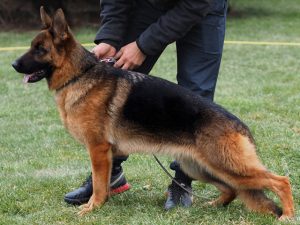
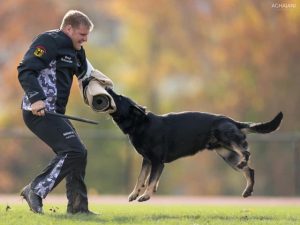
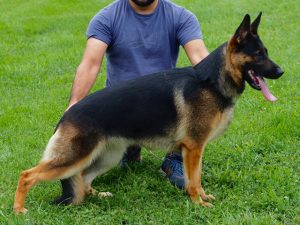
Current Generation: Tabasco, Atlas, Fida and Beyond
Fida von Nummer-Eins represents the culmination of my German Shepherd breeding philosophy—a fifth-generation dog who embodies the union I’ve spent decades pursuing. Sired by my working-line male Lupin and descended from Vesper through Nala, she inherits working drive and pigmentation from her father while maintaining the type and expression built over generations in her dam’s line.
When a respected judge told me Fida looked like “dogs from the seventies and eighties” and called her an unnecessary experiment, I understood the comment as validation rather than criticism. My German Shepherd breeding philosophy aims to produce dogs that would be correct in any era because they embody timeless principles rather than temporary fashions. Read More Here
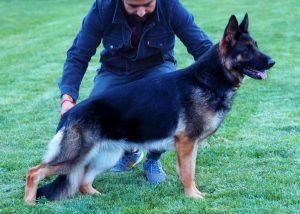

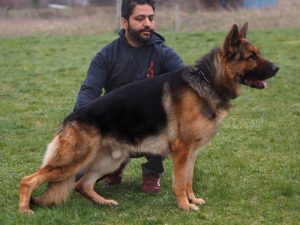

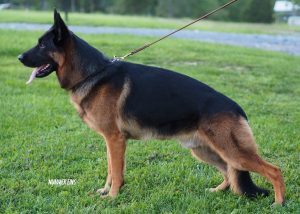
The Evidence: What the Nummer-Eins Dogs Demonstrate
After three decades, the dogs speak for themselves:
Performance Across Disciplines
From just a handful of litters, I’ve produced over 20 dogs with IPO titles and breed surveys. This success rate demonstrates that this breeding philosophy consistently produces dogs capable of excelling in working trials while maintaining proper conformation and temperament.
Real-World Application
Dogs from my breeding have found work as search and rescue animals, service dogs, family guardians, and competition partners. This versatility validates the core tenet of my German Shepherd breeding philosophy: that properly bred German Shepherds should be capable of multiple roles.
Longevity and Health
Dogs from my breeding consistently live well into their teens while maintaining good health and working ability. This longevity demonstrates that my German Shepherd breeding philosophy prioritizes sustainable genetics over short-term performance.
Client Experiences: Validation of Philosophy
The testimonials from my puppy families provide crucial validation of my German Shepherd breeding philosophy. Consistently, owners describe dogs that can switch from intense working mode to calm family companions, demonstrating the balanced temperament I breed for.
One family noted that their dog Raven “has no lack of drive, demonstrating a monstrous level of intensity when it is time to work” but “chills out and is super affectionate” at home. This perfectly illustrates what my German Shepherd breeding philosophy seeks to achieve: dogs with strong working drives who remain stable, loving family members.
Another family described their dogs as having “balanced temperaments, are highly intelligent and physically healthy” while being “aesthetically stunning.” This combination of utility and beauty reflects the core goal of my German Shepherd breeding philosophy.
The Future of German Shepherd Development
My German Shepherd breeding philosophy looks toward a future where the breed’s artificial divisions heal. This requires several shifts in thinking:
From Fashion to Function
The breeding community must return to evaluating dogs based on their adherence to breed standard rather than current winning styles. My German Shepherd breeding philosophy demonstrates that correct dogs remain correct regardless of contemporary trends.
From Specialization to Versatility
Rather than breeding dogs for specific niches, we must return to producing the versatile working dog that Stephanitz envisioned. My German Shepherd breeding philosophy proves this versatility remains achievable.
From Individual Success to Breed Stewardship
Breeders must consider their responsibility to the breed’s genetic health, not just their kennel’s success. My German Shepherd breeding philosophy incorporates this stewardship through strategic outcrossing and long-term planning.
Practical Applications of My Philosophy
For breeders interested in implementing similar approaches to German Shepherd breeding philosophy, several principles prove essential:
First Principles Thinking
Break breeding challenges into fundamental components and solve them systematically over generations rather than seeking quick fixes.
Genetic Diversity Management
Monitor population genetics and make strategic breeding decisions to maintain breed health rather than simply following popular bloodlines.
Holistic Evaluation
Assess dogs as complete organisms where temperament, anatomy, and working ability function as integrated systems rather than isolated traits.
Long-term Commitment
Think in generations rather than litters. Meaningful improvement requires sustained vision over decades.
Addressing Common Criticisms
Without a doubt my method has faced criticism from both working and show communities. Working line enthusiasts sometimes question whether my dogs have sufficient drive (to some, no dog can ever have enough drive, and to them I say, look inwards at your talent as a trainer and not outward at the dogs not being able to measure up to your expectations), while show line breeders wonder if working crosses compromise type. The dogs themselves answer these criticisms through their consistent success across multiple venues.
When people ask if crossing lines weakens either working ability or conformation, I point to dogs like O’Stryder von Nummer-Eins, who earned his IPO3 and FH1 while maintaining excellent type, or Pistol who was not only an ideal home companion to my children and us but an excellent working dog like her mother winning several accolades in working trials or Fida, who demonstrates strong work ethic, trainability and tenacity while exemplifying correct German Shepherd anatomy.
The Rin Tin Tin Ideal
At its heart, my German Shepherd breeding philosophy seeks to recreate what I call the “Rin Tin Tin ideal”—dogs capable of multiple roles while maintaining strong human bonds. This isn’t nostalgia; it’s a practical vision addressing modern needs for dogs who can serve as family companions, working partners, and guardians as circumstances require.
This ideal recognizes that most German Shepherd owners need dogs capable of adapting to various roles throughout their lives. A dog that can only succeed in one narrow function fails to meet the breed’s potential for versatility.
Utility as the True Criterion
After thirty years of developing my German Shepherd breeding philosophy, I remain convinced that Stephanitz was right: “Utility is the true criterion of beauty.” This principle guides every breeding decision, every puppy placement, and every training session.
My dogs prove that the working/show line divide need not be permanent. Through disciplined breeding, genetic stewardship, and unwavering commitment to breed standard, we can produce German Shepherds that excel across multiple criteria while maintaining the health, temperament, and working ability that define the breed.
The future of German Shepherd breeding philosophy depends on our willingness to think beyond current market pressures and temporary trends. The evidence from six generations of von Nummer-Eins dogs demonstrates that unity is possible—but only for those committed to the patient, principled approach that true breeding requires.
About the Author: Abhai Kaul has been breeding and training German Shepherds for over 30 years through his von Nummer-Eins kennel. He is a member of the German Shepherd Dog Club of America, an apprentice breed judge, and has produced multiple VA-rated dogs with working titles. His breeding philosophy emphasizes bridging the working/show line divide to produce versatile dogs that embody Max von Stephanitz’s original vision.

